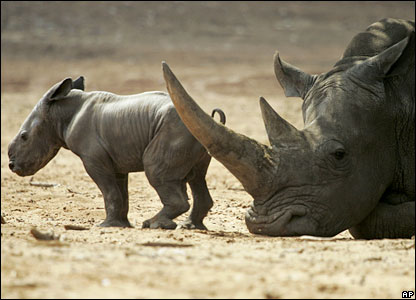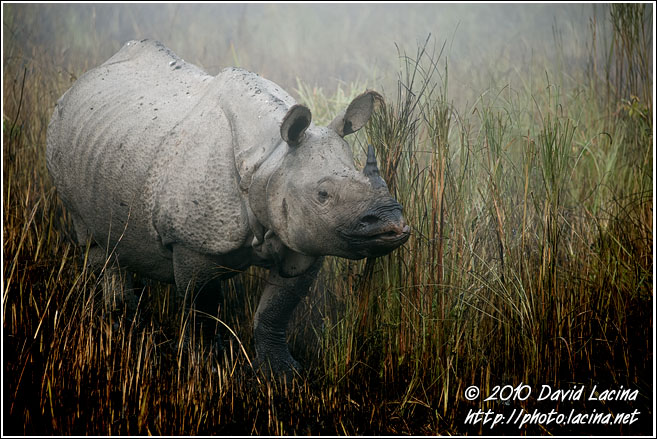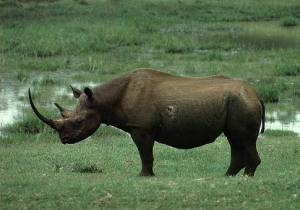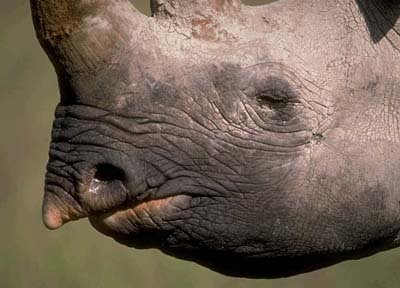This article will be written in two parts; the first part introduces you to the various species of rhino and their characteristics; the second part will go into more detail about the conservation of the rhino. The second part will be completed shortly.
There are five species of rhino, of which, 3 are found in Asia and two are found in Africa.

Newborn white rhinoceros
Their scientific classification is as follows:
| Kingdom: | Animalia |
| Phylum: | Chordata |
| Class: | Mammalia |
| Infraclass: | Eutheria |
| Order: | Perissodactyla |
| Suborder: | Ceratomorpha |
| Superfamily: | Rhinocerotoidea |
| Family: | Rhinocerotidae |
The two species native to Africa are Ceratotherium simum (white rhino) and Diceros bicornis (black rhino or hook-lipped rhino). From these two species we get a further six subspecies, two white rhino sub species; Ceratotherium simum simum (Southern whiterhino) and Ceratotherium simum cottoni (Northern white rhino). The black rhino has four sub species; Diceros bicornis minor (south-central black rhino), Diceros bicornis bicornis(South-Western black rhino), Diceros bicornis michaeli (East African black rhino) and Diceros bicornis longipes (West African black rhino). The three species native to Asia are Rhinoceros unicornis (the Indian or Greater one horned rhinoceros), Rhinoceros sondaicus (Javan rhinoceros) and Dicerorhinus sumatrensis (Sumatran rhinoceros).

The Indian Rhinoceros
White Rhinoceros:

Distribution:

- Weight: Varies, but can exceed 3,500 Kg
- Size: Length 3.5m-4.6m and a height of 1.8m-2m
- Horns: 2 on the snout, front horn is larger and averages 90 cm in length but can reach 1.5m
- Around 11,330 left in the wild
- Distinguishing characteristics:
- Prominent muscular hump which supports the head
- Flat broad mouth
- Hair located prominently on the ear an tail tips with the rest sparsely covering the body
- Colour which ranges from yellowish brown to slate grey
Black Rhinoceros:

Distribution:

- Weight: 850kg-1,600kg
- Size: Length 3.5m-3.9m and a height of 1.5m-1.75m
- Horns: 2 on the snout, front horn is larger and averages 50 cm in length but can reach 1.4m. Rarely a third horn will develop.
- Around 3,610 left in the wild
- Distinguishing characteristics:
- Smaller in size than the white rhino
- has a pointed lip for browsing leaves (see image below)
Indian rhinoceros:

Distribution:

- Weight: 2,500kg-3200kg (Females around 1900kg)
- Size: Length 3.5m-3.9m and a height of 1.75m-2m
- Horns: Single horn at a size of 20cm-60cm
- Around 2500 left in the wild
- Distinguishing characteristics:
- Colour range of brown to grey
- Hairless
- Folds of skin that resemble plates of armour
- Upper lip is semi-prehensile

Javan rhinoceros:

Distribution:

- Weight: 900kg-1400kg and 1,360kg-2000kg (various reports of weights due to rarity)
- Size: Length 3.1m-3.2m and a height of 1.5m-1.7
- Horns: Single horn at a size of up to 26cm in females no horn present or small nodule
- Less than 70 left in the wild with estimates of 27-44: it is believed the last one in Vietnam was poached in 2010.
- Distinguishing characteristics:
- Colour: Grey
- Hairless
- Folds of skin that resemble plates of armour but in a lesser form to the Indian rhino.
Sumatran Rhinoceros:

Distribution:

- Weight: around 700kg
- Size: Length 2.4m-3.15m and a height of around 1.3m
- Horns: Two horns with the front being the largest 25-79cm. The males have significantly larger horns than the females.
- Around 300 left in the wild
- Distinguishing characteristics:
- Colour of reddish brown
- Short and stubby legs
- Hair can range from dense (see image below) to scarce
- Prehensile upper lip


No comments:
Post a Comment